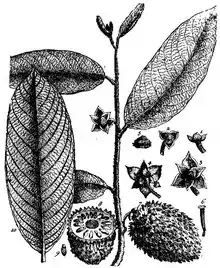Annona paludosa
Annona paludosa is a species of plant in the family Annonaceae. It is native to Brazil, French Guiana, Guyana, Suriname and Venezuela.[1] Jean Baptiste Christophore Fusée Aublet, the French pharmacist and botanist who first formally described the species, named it after its swampy (paludosus in Latin) habitat.[2][3][4]
| Annona paludosa | |
|---|---|
 | |
| Botanical illustration of Annona paludosa | |
| Scientific classification | |
| Kingdom: | Plantae |
| Clade: | Tracheophytes |
| Clade: | Angiosperms |
| Clade: | Magnoliids |
| Order: | Magnoliales |
| Family: | Annonaceae |
| Genus: | Annona |
| Species: | A. paludosa |
| Binomial name | |
| Annona paludosa | |
Description
It is a bush reaching 1.2-1.5 meters in height. Its branches have numerous light brown lenticels. Its oblong, membranous leaves are 16-20 by 6-7.5 centimeters and come to a point at their tip. The mature leaves are hairless on their green upper surface, but have woolly rust colored hairs on their reddish lower surfaces. The leaves have 18-20 secondary veins emanating from each side of their midribs. Its petioles are 5 by 3 millimeters, densely covered in woolly hairs, and have a groove on their upper surface. Its flowers are on 10-15 millimeter long peduncles that occur alone or in pairs. The peduncles are covered in woolly hairs and have a bracteole at their base and midpoint. Its sepals are united to form a calyx with 3 triangular lobes that are 10 by 10 millimeters and come to a tapering point. The outer surfaces of the sepals are covered in rust-colored woolly hairs. Its flowers have 6 petals arranged in two rows of 3. The thick, oval, outer petals have margins that touch but are not united. The outer petals are 15-18 by 15 millimeters, have a central ridge, and are covered in fine gray woolly hairs. The thinner inner petals are 14-15 by 6 millimeters and alternate with the outer petals. The inner petals are concave and covered on both surfaces with fine gray woolly hairs. Its flowers have numerous stamens that are 2.8-3 millimeters long. The velvety tissue connecting the lobes of anthers forms a cap on top of the stamens. Its flowers have numerous carpels. Its mature, oval, yellow fruit are 6 by 4 centimeters and covered in fleshy, pointed projections. Its broad, smooth, oval seeds are 8 by 4 millimeters with a prominent caruncle at their base.[3][5]
Reproductive biology
The pollen of Annona paludosa is shed as permanent tetrads.[6]
Habitat and distribution
It grows in marshy meadows.[4]
Uses
It was reported by the American agronomist and botanist Edward Lewis Sturtevant in 1919 to have edible, juicy, yellow fruit.[4]
References
- "Annona paludosa Aubl". Plants of the World Online. The Trustees of the Royal Botanic Gardens, Kew. n.d. Retrieved January 4, 2019.
- Stearn, William (2004). Botanical Latin. Portland, Ore. Newton Abbot: Timber Press David & Charles. ISBN 9780881926279.
- Aublet, Fusée (1775). Histoire des plantes de la Guiane Françoise [History of the plants of French Guiana] (in French and Latin). 1. London: P. F. Didot jeune. doi:10.5962/bhl.title.674.
- Sturtevant, E. Lewis (1919). Hedrick, U.P. (ed.). Sturtevant's Notes on Edible Plants. Albany: J.B. Lyon Company, State Printers. p. 52. ISBN 9780486204598.
- Safford, William E. (1914). "Classification of the Genus Annona with Descriptions of New and Imperfectly Known Species". Contributions from the United States National Herbarium. 18: 1–68.
- Walker, James W. (1971). "Pollen Morphology, Phytogeography, and Phylogeny of the Annonaceae". Contributions from the Gray Herbarium of Harvard University. 202 (202): 1–130. JSTOR 41764703.